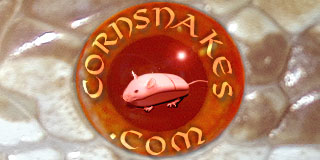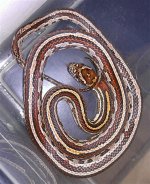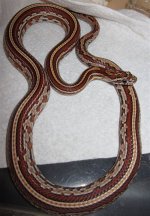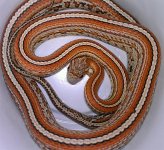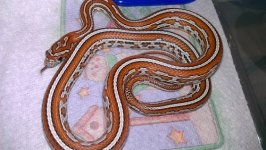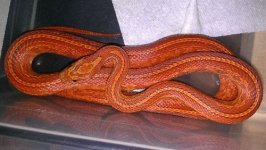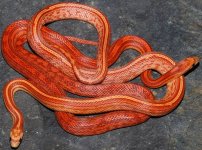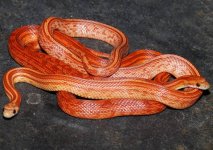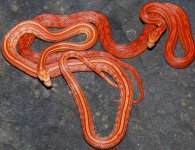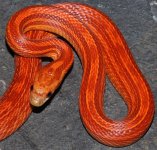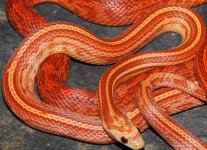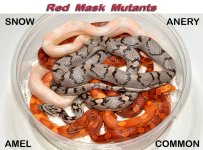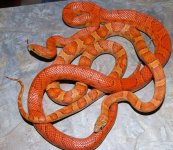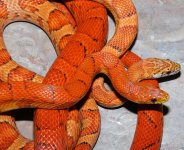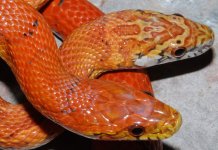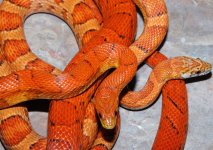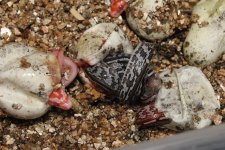RedCoat vs Non-RedCoat (Normal)
I think many morphs such as the Cayenne’s may be a combination of both Red Mask and RedCoat. I think there are a lot of very nice Bloodred lines that have these two influences. I do not believe that RedCoat is something new, but something that has been around a long time, we just haven’t picked up on it, much like Diffused.
Bloodreds were bred for many years, without anybody realizing there was a pattern trait involved until Chuck Pritzel noticed something that was right under our nose all the time. Many people quit calling them Bloodreds and started calling them Diffuse, but old timers like myself would not give up the Bloodred name and insisted there was something in Bloodreds that CAUSED red in Corns. I believe we were right all along, and the cause was RedCoat and/or Red Mask.
One of the problems, or reasons we haven’t picked up on some of these minor genes, is that we selectively breed our morphs within the mutation such as Anerys, Lavenders and Caramels, without knowing what the minor genes are doing to the Normal phase in the line. I judge Bloodreds such as Plasmas and Granites by the Bloodred phase they produce when outcrossed.
The difference between Red Mask and RedCoat to me is that Red Mask adds red or pink to the background area of Corns such as Neons. This is based upon Don S description and the examples in the first photo I have attached that Don sent me. RedCoat is a top layer of Red pigment that appears as if you covered the Corn with red cellophane. The best example of RedCoat can be seen when comparing RedCoat and Non-RedCoat siblings from the same clutch.
The best photographic examples I have are the comparison photos I have attached of sibling RedCoat Sunkissed and Non-RedCoat Sunkissed, or normal Sunkissed. You can easily see the addition of RedCoat in these comparison photos. Like I stated above, RedCoat is not something new. I have produced it from several mutant lines, such as Okeetees, Bloodred, Lavenders and even Butters. Some of the nicest Butters with very saturated color are RedCoats and most of them have been visually selected for another minor gene, or at least one we haven’t considered that I call the “Yellow Disease”.
The Yellow Disease in not a disease at all, but if you want to get rid of it, it is difficult because it seems to be dominant, like Tessera. Homo Yellow x Normal you get 100% Yellow pheno, but it is het Yellow. Het Yellow x Het Yellow only produces 1 in 4 that do not have the Yellow pheno. Due to my preference for Red in most of my morphs, I have noticed that morphs such as Butter Motleys and Striped Butters carry this dominant Yellow gene. When I breed my RedCoat Red Amels x Rich Z Butters, I get a tangerine colored morph. When I breed any morph X Butter Motleys and produce Normals, they are not normal colored. Their browns are changed to tans and reds to orange.
When I created my original Topaz line, I bred a RedCoat Landrace (Wild Line) Lava X Rich Z Butter Motley. You would think that I would have produced Normals het Lava Butter Motley, but my results in F1 indicated there were several other possible minor genes involved. The best example of this is the father of one of Topaz. Many people have said that my Topaz seem to have something that others do not, which I believe is RedCoat and a Dominant Yellow gene. Here is a link to his ACR registration ACR 8372
http://herpregistry.com/acr/Registry.php?idnum=8372 . If you look at his father’s photo, ACR 2088, you will see a Corn that is anything BUT normal. His pheno seems to be a RedCoat, Yellow Disease, Border-less het Lava Butter Motley. Remember he is an outcross from two very different lines (Wild Line and Rich Z line) and a F1. I believe RedCoat was on both sides of his breeding, and perhaps Border-less, which I think is dominant too, and the Butter Motley added the Yellow Disease into the mix.
If you are looking for 100% proof of these three possible minor genes, I do not think I can provide it, but I consider these three minor genes (RedCoat, Yellow Disease, and Border-less) in my breedings. As far as how they are inherited, I believe RedCoat is recessive or variable co-dominant like Diffused, and the Yellow Disease and Border-less are dominant, or at least co-dominant to Normal.
I have hypothesized that the Yellow Gene may mask the pinks in our Snows and Anerys and it definitely acts like a hypo gene. Anerys and Lavenders especially are much lighter. It changes the blacks in Anery to gray, the purple in Lavender, to lavender, and the browns in Normal to tan. The cause of Silverqueens, for example, may the Yellow gene.
All of the above is just my opinion. I am not trying to claim I discovered a NEW gene or anything like that, so please don’t get all up tight. The names I am using such as RedCoat, Yellow Disease, Yellow Gene and Border-less, are just the names I use to discuss the subject and will either be accepted in time or a better name will be eventually. This is just useful information that I consider when breeding my Corns and it may be something that may be useful in your breedings as well.
